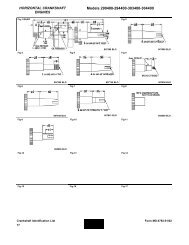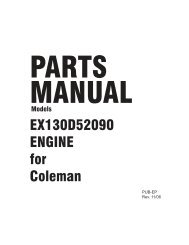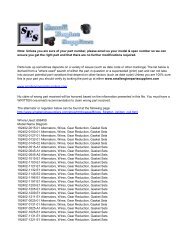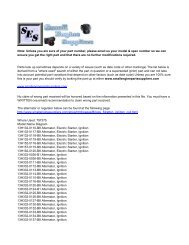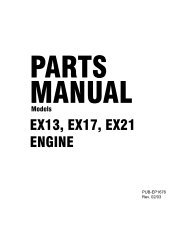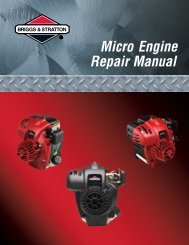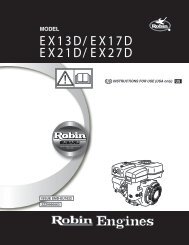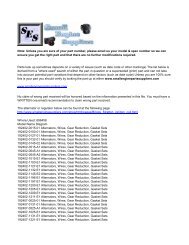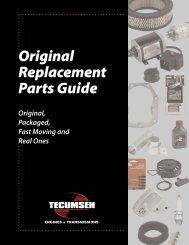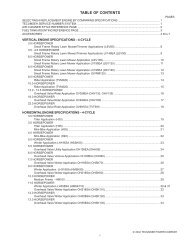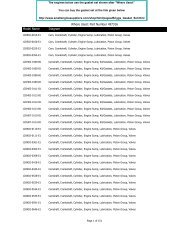3to 11hp 4-cycle l-head engines - Small Engine Suppliers
3to 11hp 4-cycle l-head engines - Small Engine Suppliers
3to 11hp 4-cycle l-head engines - Small Engine Suppliers
You also want an ePaper? Increase the reach of your titles
YUMPU automatically turns print PDFs into web optimized ePapers that Google loves.
Begin the procedure by replacing the points if necessary.<br />
To do this remove the nut that secure the movable portion<br />
of the breaker points. Remove the screw from the<br />
stationary portion of the breaker points and the worn<br />
breaker point assembly. Install a new breaker point<br />
assembly and adjust the point gap. This is done by rotating<br />
the crankshaft until the point arm is resting on the high<br />
side of the ignition cam. Set the point gap by loosening<br />
the screw on the movable point set and insert a feeler<br />
gauge per specification. Adjust the point gap so that a<br />
light drag is felt on the feeler gauge. Tighten the screw<br />
and recheck the gap. Leave the leads unattached for the<br />
timing procedure. Use this procedure on all standard point<br />
ignition systems when point replacement is necessary<br />
(diag. 21).<br />
CRANKSHAFT<br />
ARM<br />
PIVOT<br />
IGNITION<br />
CAM<br />
POINTS<br />
DIAL SCREW<br />
21<br />
Install a dial indicator (Part # 670241), equipped with the<br />
correct tip on the extender leg. Use the small tip for<br />
<strong>engines</strong> with timing dimensions of between top dead<br />
center (T.D.C.) and .050" (1.27 mm) before top dead<br />
center (B.T.D.C.). Use the large tip for <strong>engines</strong> with timing<br />
dimensions of between .051" (1.295 mm) B.T.D.C. to<br />
.150" (3.81 mm) B.T.D.C. Make sure to secure the<br />
extender leg in position to locate the tip directly over the<br />
piston <strong>head</strong>. Loosen the screw on the side of the adaptor<br />
sleeve to allow the sleeve to be turned into the threads of<br />
the spark plug hole, not the entire dial indicator. This will<br />
ensure the proper location of the tip. Once the adapter<br />
sleeve is secured in the hole, tighten screw on sleeve<br />
adaptor to prevent the dial from moving up or down, which<br />
would give a false reading (diag. 22).<br />
SLEEVE<br />
SLEEVE<br />
SCREW<br />
22<br />
Find T.D.C. with both valves closed by rotating the<br />
crankshaft clockwise when looking at the magneto end<br />
of the crank, until the needle on the dial stops and<br />
reverses direction. Where the needle stops is T.D.C.<br />
Loosen the screw on the dial, and rotate the dial so that<br />
zero is lined up with the needle at T.D.C. Tighten the screw<br />
on the dial to secure it in place (diag. 23).<br />
DIAL AT 0"<br />
23<br />
While watching the needle on the dial indicator, rotate<br />
the crankshaft counterclockwise when looking at the<br />
magneto end of the crank, .010" (.254 mm) past the<br />
B.T.D.C. dimension. Then rotate the crankshaft clockwise<br />
to the proper B.T.D.C. dimension, this will take out any<br />
slack between the connecting rod and crankshaft<br />
assembly.<br />
DIAL AT<br />
.090"<br />
(2.286 mm)<br />
DIAL AT<br />
.080"<br />
(2.032 mm)<br />
Example: If the specification of .080" (2.032 mm) is the<br />
B.T.D.C. dimension, rotate the crankshaft counterclockwise<br />
so that the needle on the dial indicator travels<br />
to .090" (2.286 mm) B.T.D.C. (diag. 24), then rotate the<br />
crankshaft clockwise so that the needle travels to the<br />
specified dimension of .080" (2.032 mm) B.T.D.C. (diag.<br />
25).<br />
24<br />
25<br />
Next, if the original breaker points are being used,<br />
disconnect the leads from the point terminal. Reinstall<br />
the nut & tighten. Connect one lead of a continuity light,<br />
or ohmmeter to the point terminal and the other lead to a<br />
good ground. Loosen the two bolts holding down the stator<br />
and rotate the stator until the continuity light or ohmmeter<br />
indicates a break in the circuit. Torque down the stator<br />
bolts while maintaining the stator plate position and the<br />
timing procedure is completed. Reconnect the leads on<br />
the point terminal and tighten the nut making sure that<br />
the leads do not touch the flywheel (diag. 26).<br />
(continued on top of next page)<br />
26<br />
69



